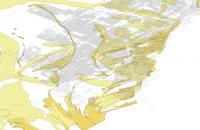Professor in Residence, Department of Architecture, GSD, Harvard University, Cambridge MA, USA
Ecologies of Leisure: Reimagined Architectures and Landscapes of Leisure and Infrastructure
VOLUME 6/2021 - Issue 1 , Pages: 197 - 218 published: 2021-06-14The research detailed in this paper revolves around an ecological and spatial exploration for a derelict coastal area in Lebanon. It frames the possibility for an agile ecological approach to design, one that builds upon the latent derelict aspects and persisting disconnections in this specific area and that reimagines a potential new reality intermeshing the natural with the human and the infrastructural with the architectural. Within the format of a research undergraduate studio, the approach and work discussed here present possible synthetic scenarios for coastal developments in Lebanon, and suggest alternative production, programmatic, and ecological strategies.
The Adaptive Island: Proving Ground for Temporal Awareness in the Anthropocene
VOLUME 7/2022 - Issue 1 , Pages: 177 - 196 published: 2022-06-17Peddocks Island is a 200-acre [80.9 ha] island which is part of The Boston Harbor Islands National Recreation Area (US). The island has limited public transportation and is rarely visited by humans. Its use and ecology has transformed throughout history and it is now positioned to transform again with climate change and rising sea levels. This article suggests that the island’s history, geology, mythology, and ecology situate it perfectly to experience climate change’s temporal and spatial impacts. Amitav Ghosh points out the need to communicate and narrate the uncertainty of the changing climate and build temporal awareness through narratives. In this work, we suggest the island as a “living lab,” available for both controlled observations and for the public to experience the realities of climate change. This article provides tangible and experiential concepts for Ghosh’s question by exploring mutable and ephemeral infrastructure design strategies
Cities as Hydro-Geologic Terrain: Design Research to Transform Urban Surfaces
VOLUME 3/2018 - Issue 1 , Pages: 165 - 190 published: 2018-07-02Imperviousness is a significant design problem for the future of cities: we must reduce it, redesign it, transform it. This paper argues to insert hydro-terrain thinking to the paved surfaces of cities, instantiating the concept of “rain terrain” that links hydrologic performance across scales, from the raindrop to the region. The City of Chicago is the case study where high concentrations of pavement drain stormwater from the city - resulting in flooding, overflowing and polluting - from the Great Lakes to the Gulf of Mexico. I first share research on the glaciated history of the region, to reveal sandy soil types located in the urban area. I then correlate imperviousness, permeable soils and flooding prevalence to identify a pattern of site opportunity areas in the city. I also propose design practices - through disruptions, interventions and reconfigurations of urban surface - to tap paved-over soils as the basis for a landscape-based urban stormwater approach. In doing so, this paper aims to present a vision for urban transformation, based on specific technical design opportunities within landscape-as-infrastructure.
Chicago’s Urban Rivers
VOLUME 3/2018 - Issue 1 , Pages: 141 - 164 published: 2018-07-02Chicago, like other major cities, traces its growth back to a connection with water. As the city grew, the river became the backbone of commerce and economic prosperity. However, this thriving resource was not always looked upon with a sense of stewardship and care. In the wake of post-industrialization, much of the manufacturing had moved from the banks of the Chicago River, leaving behind disconnected communities and a polluted riverbed. For nearly two decades, Ross Barney Architects has been working along Chicago’s rivers. These efforts include the design of the Chicago Riverwalk, studies on all 150 mi. [241 km] of riverfront across the city, and an exhibition at the Chicago Architecture Biennial. The goal was to reconnect people with the dynamic and changing life of the river.




















